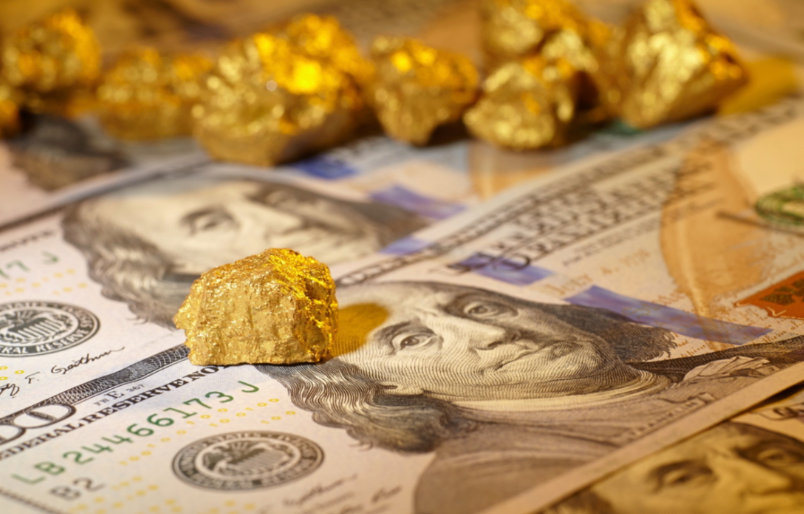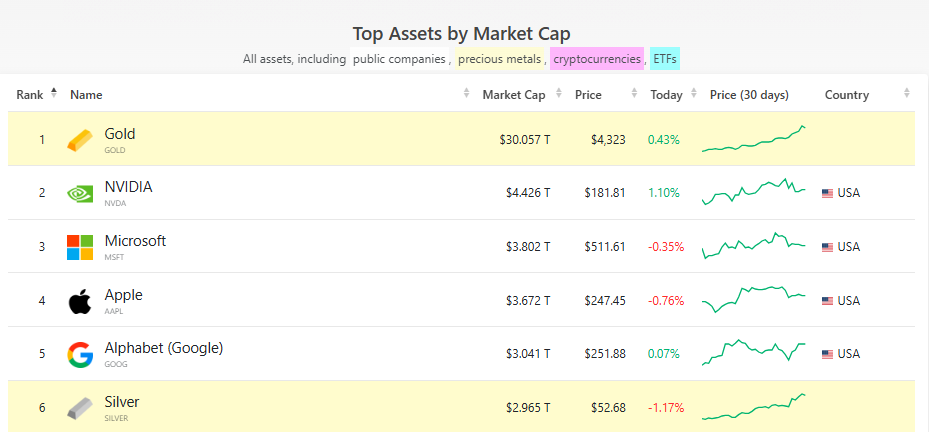
Recently, according to data from the CompaniesMarketCap website, the total value of global gold has exceeded $30 trillion as gold prices continue to hit new all-time highs, far ahead of all types of assets.
How did this number come about? It is calculated by multiplying the gold that has been mined in the world (about 216,000 tons, according to data from the World Gold Council) by the current gold price.
This shows that gold is not just an "old antique" safe-haven tool, but is now back in popularity. In the context of high inflation and international tensions, more and more investors feel that gold is a "hard currency" that is more reliable and reassuring.

Gold is being redefined
Since 2025, international gold has risen sharply, far outperforming stocks and bonds, and has stepped out of an "independent bull" market. This round of rise is not just about "risk aversion", but the position of gold in the investment market is fundamentally changing - it is changing from a "backup" safe-haven tool to a "core role" in investors' asset allocation.
There are three main reasons for the rise in gold prices: policy changes, geopolitical risks, and the change in the people who buy gold.
1. Policy expectations have changed: everyone is beginning to worry that "money is not worth it"
The continuous adjustment of U.S. trade and monetary policy has made the market increasingly worried about the future:
The imposition of "reciprocal tariffs" could drag down the economy and trigger a recession, while fearing a resurgence of inflation. The Fed shifted from "raising interest rates" to "cutting interest rates", releasing a lot of liquidity, and the U.S. Treasury bonds piled up higher and higher, and the government almost "shut down".
All of this has weakened investors' confidence in the US dollar and they have begun to think: Can the US dollar continue to be the "world currency"?
In this context, gold, which does not belong to any country, has naturally been re-emphasized, and its value has been systematically "raised".
2. Geopolitical conflicts continue: the world is not peaceful, and everyone wants to "hide"
The Russian-Ukrainian war continues, the situation in the Middle East is tense from time to time, and conflicts have emerged from time to time in Asia, Africa, and Latin America. This feeling that "something can happen anywhere" is becoming a "new normal". As a result, global funds have sought safe havens, and gold has become the first choice.
3. People who buy gold have changed: the central bank has become a "super buyer"
In the past, gold was mainly bought by retail investors and funds, but now the biggest buyers are central banks. According to the World Gold Council:
From 2022, central banks around the world will buy more than 1,000 tons of gold every year, twice the annual average level of the previous decade; In the third quarter of 2025, the central bank's gold purchase momentum remained strong, becoming the most stable force supporting gold prices.
The central bank buys gold not to make money in the short term, but to adjust the structure of foreign exchange reserves and reduce dependence on the US dollar. This kind of "official rigid need" is more durable and firmer than ordinary investment.
There is also a bright spot: gold ETFs are on fire
Gold ETFs (exchange-traded funds) make it easy for ordinary people to invest in gold. In the third quarter of 2025, global gold ETFs saw net inflows for three consecutive months:
In July and August, mainly North American and European funds were buying; the largest single-day inflow in September reached 26.8 tons (about US$1.7 billion), a record; a total of about 130 tons of holdings were increased throughout the quarter, and the total position was close to the highest level in history; The total assets under management exceeded $407 billion for the first time.
Driving this wave of buying is the Fed's interest rate cuts, real interest rates falling below 1%, the weakening of the US dollar, coupled with tensions in the Middle East and US tariff uncertainty - safe-haven + anti-inflation demand exploded at the same time.
Gold is more reliable than the US dollar
Bank of America said in its latest report: "The White House's 'unusual' policies will continue to support gold." They mentioned that the U.S. fiscal deficit is getting higher, debt is ballooning, and the Fed is under pressure to cut interest rates - all of which have weakened market confidence in the dollar and pushed up the value of gold.
Société Générale believes that the rise in gold prices is driven by the continuous inflow of gold ETF funds and the strong demand from central banks to buy gold. Of course, whether the price of gold can continue to rise in the future, no one dares to pack a ticket, and it will take time to verify. Especially when the price of gold rises too fast, there may be a short-term correction, and investors are prone to panic, not knowing whether to enter or exit.
But remember one thing: once the general trend is formed, it will not change easily, and the fluctuations in the middle are just "small episodes". Looking at the latest data, you can feel how heavy the "weight" of gold is:
According to CompaniesMarketCap, as gold prices continue to set new records, the total market value of global gold has exceeded $28 trillion, ranking first in global assets, leaving other assets far behind.
What is this concept? Let's do the math: add up the market capitalization of all the "top" companies: the top 10 companies such as Nvidia ($4.585 trillion), Microsoft ($3.821 trillion), Apple ($3.675 trillion), and Google ($2.952 trillion) add up to about $27 trillion - not as much as gold's $28 trillion!
No wonder Dalio, founder of Bridgewater, the world's largest hedge fund, said: The current situation is very similar to the 70s of the last century - high inflation, currency depreciation, geopolitical turmoil. He advised investors that even if the price of gold has risen to more than $4,000 per ounce, they should invest 15% of their portfolio in gold.
Gold ETFs are a good choice
In the third quarter of 2025, central banks around the world continued to buy gold steadily, and this trend of "structural overweight" did not change. It is expected that in the fourth quarter, the main buying force will still be emerging market countries, driven by geopolitical tensions and the adjustment of the global monetary system. The annual gold purchase volume is expected to be close to the forecast target of 1,000 tons.
Not only are central banks buying, but now even sovereign funds (national investment funds), family offices (wealth management teams of the wealthy), and ordinary investors in emerging markets have begun to regard gold as a "standard" in their investment portfolios.
The increasing number of buyers and types has made the gold market more active, but it has also complicated price changes.
So what is the "ETF fund" mentioned by Société Générale? In the early days of this round of gold rise, it was mainly driven by large funds from the central bank and the futures market, and ordinary retail investors and funds did not participate much.
But when the rise in gold prices became more and more stable, especially after the Federal Reserve clearly cut interest rates, many funds that were originally waiting and seeing began to enter. They are often bought through the convenience of gold ETFs (exchange-traded funds).
This is like the second wave of "main forces" entering the market, which will further push up the price of gold.
If the central bank's gold purchase is a "long-term ballast stone", then ETF capital inflows are "accelerators". Once the two form a joint force, the price of gold may rush higher.
How can ordinary investors participate? Gold ETFs are a good choice
There are two main types of gold ETFs on the market:
Gold ETF Huaxia (518850)
The underlying asset is the spot gold of the Shanghai Gold Exchange, and the price fluctuates directly with the price of gold, supporting T+0 trading (buying on the same day and selling on the same day), which is flexible and convenient.
Gold Stock ETF (159562)
Invest in gold stocks, such as gold mining companies, heavy stocks include: Zijin Mining, Shandong Gold, CICC Gold, etc., but also include some jewelry brands, such as Laopu Gold, Chow Tai Fook, which belong to equity ETFs, which fluctuate more than physical gold, but also have greater potential.
If you want to follow the price of gold steadily, choose a physical gold ETF; If you want to earn higher returns and withstand volatility, you can consider gold stock ETFs. In short, there are many ways to buy gold now, and ordinary people can easily participate in this round of "gold market".





